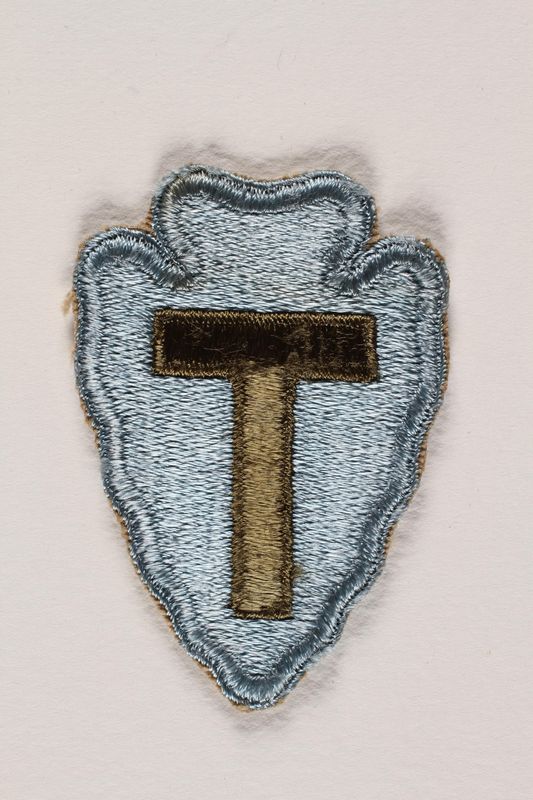Overview
- Brief Narrative
- Shoulder sleeve insignia of the United States Army 36th Infantry Division, known as the Texas or Arrow Head Division, and as well as the Lone Star or Panther Division. The arrowhead shaped blue badge wit a green T represents the National Guard troops from Oklahoma and Texas who formed the unit when it was established in 1917. The 36th landed in North Africa on April 13, 1943. In early September, the unit entered combat in the Italian campaign, suffering severe losses. The 36th had the ninth highest casualty rate of any Army Division in World War II. On August 14, 1944, the Division was redeployed to France, and advanced into Bavaria in late December. On April 30, 1945, the 36th liberated a subcamp of the Kaufering concentration camp system, a complex of Dachau subcamps in the Landsberg area. The unit had crossed into Austria when Germany surrendered on May 7. The Division was assigned occupational duties and returned to the US on December 15, 1945, and inactivated the same day.
- Date
-
unavailable:
- Credit Line
- United States Holocaust Memorial Museum Collection
Physical Details
- Classification
-
Military Insignia
- Category
-
Badges
- Object Type
-
Color patches (military patches) (aat)
- Physical Description
- Arrowhead shaped military patch machine embroidered on white netting with a green T embroidered on a light blue field. The arrowhead has a notched top and points downward; the edges are scalloped and have an embroidered blue border. The patch has no visible signs of use.
- Dimensions
- overall: Height: 2.500 inches (6.35 cm) | Width: 1.250 inches (3.175 cm)
- Materials
- overall : thread, net
Rights & Restrictions
- Conditions on Access
- No restrictions on access
- Conditions on Use
- No restrictions on use
Keywords & Subjects
Administrative Notes
- Legal Status
- Permanent Collection
- Provenance
- The badge was acquired by the United States Holocaust Memorial Museum in 2004.
- Record last modified:
- 2023-08-25 16:06:34
- This page:
- https://collections.ushmm.org/search/catalog/irn35179
Download & Licensing
In-Person Research
- By Appointment
- Request 21 Days in Advance of Visit
- Plan a Research Visit
- Request to See This Object
Contact Us
Also in United States Army division shoulder sleeve insignia badge collection
The collection consists of thirty-five United States Army Division shoulder sleeve insiginia badges issued for Divisions active in the European theater during World War II.
Date: approximately 1940-approximately 1945
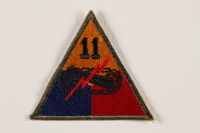
US Army 11th Armored Division shoulder sleeve patch with tank tracks, gun, and red lightning bolt
Object
Shoulder sleeve insignia, 11th Armored Division, United States Army, known as the Thunderbolt Division, of the type used during World War II. The patch design was used by all Armored divisions, with the division number, in this case 11, at the apex of the triangle. The colors represent the military branches that form an armored division: yellow for cavalry, blue for infantry, and red for artillery. The symbols represent the characteristics: the tank track, mobility and armor protection; the cannon, fire power; and the red flash of lightning, shock action. The 11th Division landed in Normandy on December 16, 1944, and their rapid march across France to the Meuse River, 350 miles in four days, earned them the nickname Thunderbolt. On May 5, 1945, the 11th entered Linz. They liberated two of the largest concentration camps in Austria, Mauthausen, and a subcamp, Gusen, on May 5 and 6. They discovered 19,000 prisoners in deplorable conditions, and thousands needing immediate medical care. The Division provided medical assistance and arranged for the burial of the dead. Germany surrendered on May 7. The Division ended the war in Amstetten, Austria, where they met with Soviet forces on May 8, 1945. The Division was placed on occupation duty until it was inactivated on August 31, 1945. This Division was active only during World War II.
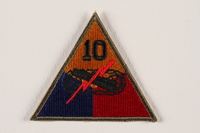
US Army 10th Armored Division shoulder sleeve patch with tank, gun, and red lightning bolt
Object
Shoulder sleeve insignia,n10th Armored Division, United States Army, known as the Tiger Division, of the type used during World War II. The patch design was used by all Armored divisions, with the division number, in the case 10, at the apex of the triangle. The colors represent the military branches that form an armored division: yellow for cavalry, blue for infantry, and red for artillery. The symbols represent the characteristics: the tank track, mobility and armor protection; the cannon, fire power; and the red flash of lightning, shock action. The 10th Division arrived in Cherbourg, France, on September 23, 1944. They advanced through Germany, capturing several cities during nearly sixty-nine days of continuous combat. The 10th liberated a subcamp of Dachau concentration camp in the Landsberg area on April 27, 1945. The Division had reached Innsbruck, Austria, when Germany surrendered on May 7, 1945. It was placed on occupation duty until inactivated on October 13, 1945. This Division was active only during World War II.
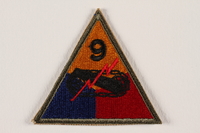
US Army 9th Armored Division shoulder sleeve patch with tank, gun, and red lightning bolt
Object
Shoulder sleeve insignia, 9th Armored Division, United States Army, known as the Phantom Division, of the type used during World War II. The patch design was used by all Armored divisions, with the division number, in this case 9, at the apex of the triangle. The colors represent the military branches that form an armored division: yellow for cavalry, blue for infantry, and red for artillery. The symbols represent the characteristics: the tank track, mobility and armor protection; the cannon, fire power; and the red flash of lightning, shock action. The 9th Division landed in Normandy in September 1944, and earned their nickname Phantom while fighting in the Battle of the Bulge. They advanced through Germany, where they captured the Ludendorff Bridge over the Rhine River in Remagen on March 7, 1945. They had pushed into Czechoslovakia when Germany surrendered on May 7, 1945. On May 8th, troops of the 9th and 1st Infantry Division liberated Zwodau and Falkenau an der Eger labor camps, subcamps of Flossenbürg concentration camp. They found 900-1000 starving female prisoners at Zwodau. The Divisions provided medical attention and food to the survivors. The 9th was placed on occupation duty until their return to the US on October 10 and inactivation on October 13, 1945. This Division was active only during WWII.

US Army 8th Armored Division shoulder sleeve patch with tank, gun, and red lightning bolt
Object
Shoulder sleeve insignia, 8th Armored Division, United States Army, of the type used during World War II. It was originally known as the Thundering Herd, but became known as Iron Snake following an article in Newsweek that called the unit “A Giant Ironclad Snake.” They were also known by their war code name, Tornado. The patch design was used by all Armored divisions, with the division number, in this case 8, at the apex of the triangle. The colors represent the military branches that form an armored division: yellow for cavalry, blue for infantry, and red for artillery. The symbols represent the characteristics: the tank track, mobility and armor protection; the cannon, fire power; and the red flash of lightning, shock action. The 8th Division landed in France on January 5, 1945, fought its way through France and Holland, and entered Germany in March. Near Langenstein, troops of the 8th and 83rd Infantry Division encountered a group of adjacent subcamps of Buchenwald concentration camp. The 8th liberated Halberstadt-Zwieberge subcamp between April 11 and 17, 1945. Germany surrendered on May 7, 1945, and the Division was placed on occupation duty until inactivated on November 14, 1945. This Division was active only during WWII.
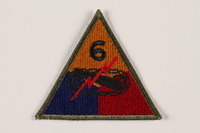
US Army 6th Armored Division shoulder sleeve patch with tank, gun, and red lightning bolt
Object
Shoulder sleeve insignia of the 6th Armored Division, United States Army, known as the Super Sixth Division, of the type used during World War II. The patch design was used by all Armored divisions, with the division number, in this case 6, at the apex of the triangle. The colors represent the military branches that form an armored division: yellow for cavalry, blue for infantry, and red for artillery. The symbols represent the characteristics: the tank track, mobility and armor protection; the cannon, fire power; and the red flash of lightning, shock action. The 6th Division landed in Normandy on July 18, 1944, and advanced through France, liberating several towns. After fighting in the Battle of the Bulge, they moved through Germany and captured many towns. The Division liberated Buchenwald concentration camp on April 11, 1945. The SS guards had fled and prisoners were in control of the camp. There were 21,000 survivors in the camp. Germany surrendered on May 7, 1945. The Division was placed on occupation duty in Germany until inactivated on September 18, 1945.

US Army 4th Armored Division shoulder sleeve patch with tank and red lightning bolt
Object
Shoulder sleeve insignia of the 4th Armored Division, United States Army, known as the Name Enough Division, of the type used during World War II. The patch design was used by all Armored divisions, with the division number, in this case 4, at the apex of the triangle. The colors represent the military branches that form an armored division: yellow for cavalry, blue for infantry, and red for artillery. The symbols represent the characteristics: the tank track, mobility and armor protection; the cannon, fire power; and the red flash of lightning, shock action. The 4th Division landed at Utah Beach in Normandy on July 11, 1944 and entered combat in France. The division commander refused to sanction an official nickname, saying the 4th was name enough, leading to the unofficial nickname, Name Enough. Their role in the breakout from the Normandy beachhead and the liberation of France in 1944 earned them a second unofficial nickname, Breakthrough. They fought their way through Germany. On April 4, 1945, they liberated Ohrdruf concentration camp, a subcamp of Buchenwald, the first concentration camp to be liberated by American troops, and visited by General Eisenhower on April 12. When Germany surrendered on May 7, 1945, the Division was in Czechoslovakia. The 4th was placed on occupation duty until inactivated on April 26, 1946.
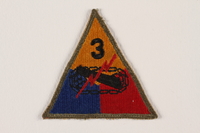
US Army 3rd Armored Division shoulder sleeve patch with tank, gun, and red lightning bolt
Object
Shoulder sleeve insignia, 3rd Armored Division, United States Army, known as the Spearhead Division, of the type used during World War II. The patch design was used by all Armored divisions, with the division number, in this case 3, at the apex of the triangle. The colors represent the military branches that form an armored division: yellow for cavalry, blue for infantry, and red for artillery. The symbols represent the characteristics: the tank track, mobility and armor protection; the cannon, fire power; and the red flash of lightning, shock action. The 3rd Division landed in Normandy in late June 1944, where their role as the spearhead in many attacks during the liberation of France in 1944 earned them their nickname. They pushed on and were the first Allied ground force to invade Germany. While fighting through Germany, they were first to capture a German town and to breach and advance across the Siegfried Line in September 1944. They were also the first Allied ground force to capture a major German city, when they captured Cologne on March 5 and 6, 1945. The 3rd and the 104th Infantry Division liberated Dora-Mittelbau concentration camp and Boelcke-Kaserne, a subcamp of Mittlebau, on April 11, 1945. They immediately began transporting 250 ill and starving survivors to nearby hospitals. Germany surrendered on May 7, 1945. The Division was placed on occupation duty in Germany until inactivated on November 10, 1945.
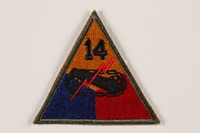
US Army 14th Armored Division shoulder sleeve patch with tank and red lightning bolt
Object
Shoulder sleeve insignia, 14th Armored Division, United States Army, known as the Liberators, of the type used during World War II. The patch design was used by all Armored divisions, with the division number, in this case 14, at the apex of the triangle. The colors represent the military branches that form an armored division: yellow for cavalry, blue for infantry, and red for artillery. The symbols represent the characteristics: the tank track, mobility and armor protection; the cannon, fire power; and the red flash of lightning, shock action. The 14th Division landed in Marseilles, France on October 29, 1944, and entered combat along the French-Italian border. They advanced into Germany in December 1944. Between May 2 and 3, 1945, the 14th liberated several subcamps of Dachau concentration camp. Near the towns of Ampfing and Muhldorf, the Division discovered four large underground munitions plants and three large forced labor camps, housing thousands of Polish and Soviet prisoners. The Division also liberated two other camps nearby, one holding Jewish female prisoners and the other holding 1,500 Jewish prisoners, of whom only 900 could walk. The Division became known as Liberators because they liberated thousands of concentration camp prisoners and Allied prisoners of war in 1945. When Germany surrendered on May 7, 1945, the Division was processing prisoners of war in Germany. The Division was placed on occupation duty until inactivated on September 16, 1945. This Division was only active during WWII.

US Army 20th Armored Division shoulder sleeve patch with tank, gun, and red lightning bolt
Object
Shoulder sleeve insignia, 20th Armored Division, United States Army, sometimes called Armoraiders, of the type used during World War II. The patch design was used by all Armored divisions, with the division number, in this case 20, at the apex of the triangle. The colors represent the military branches that form an armored division: yellow for cavalry, blue for infantry, and red for artillery. The symbols represent the characteristics: the tank track, mobility and armor protection; the cannon, fire power; and the red flash of lightning, shock action. The 20th Division landed in Le Havre, France, on February 16, 1945. They advanced through Belgium into Germany. They were one of the three US Army divisions that liberated Dachau concentration camp on April 29, 1945. They discovered over 30,000 survivors in the camp and 2,310 corpses on a train. On April 30, 1945, they captured Munich. When Germany surrendered on May 7, 1945, the Division was in Austria. The Division was placed on occupation duty until they returned to the US on August 2, 1945, and were inactivated on April 2, 1946. This Division was active only during WWII.

US Army 12th Armored Division shoulder sleeve patch with tank, gun, and red lightning bolt
Object
Shoulder sleeve insignia, 12th Armored Division, United States Army, known as the Hellcat Division, of the type used during World War II. The patch design was used by all Armored divisions, with the division number, in this case 12, at the apex of the triangle. The colors represent the military branches that form an armored division: yellow for cavalry, blue for infantry, and red for artillery. The symbols represent the characteristics: the tank track, mobility and armor protection; the cannon, fire power; and the red flash of lightning, shock action. The 12th Division landed in Le Havre, France, on November 11, 1944, and liberated Colmar. They moved into Germany, capturing several cities and the first intact bridge over the Danube River at Dillingen. The 12th and the 101st Airborne Division liberated Kaufering IV concentration camp, a subcamp of Dachau in the Landsberg area, on April 27, 1945. They discovered sick prisoners who had been left behind when the camp was evacuated to Dachau. The Division had reached Austria when Germany surrendered on May 7, 1945. The Division was placed on occupation duty until inactivated on December 3, 1945. This Division was active only during WWII.
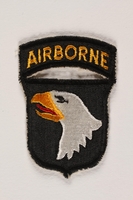
US Army 101st Airborne Division shoulder sleeve patch with a bald eagle head
Object
Shoulder sleeve insignia, 101st Airborne Division, United States Army, known as the Screaming Eagles. The shield shaped badge has an Airborne banner and a bald eagle, originally representing a Civil War mascot named Old Abe, the origin of the unit’s nickname. The Airborne parachuted into Normandy, France, on D-Day, June 6, 1944, to clear the way for troops to land on Utah Beach. In September, it was part of the Allied attempt to liberate the Netherlands during Operation Market Garden. The Unit was in southern Germany in late April 1945, where it discovered Kaufering IV, a subcamp of Dachau concentration camp. The 101st Airborne and the 12th Armored Divisions liberated the camp on April 27th and 28th. They found approximately 500 dead prisoners; the other inmates had been transported by SS guards as Allied Forces closed in. The Divisions forced local residents to bury the dead. The Unit was moving toward Berchtesgaden when Germany surrendered on May 7, 1945. The 101st Division was part of the Army of Occupation until their inactivation in Germany on November 30th, 1945.

US Army 82nd Airborne Division shoulder sleeve patch with two stylized letter A’s
Object
Shoulder sleeve insignia, 82nd Airborne Division, United States Army, known as the All American, of the type used during World War II. It is a square patch with Airborne on a banner and stylized letter A’s in the national colors, red, white, and blue. Actiivated in 1918 during World War I, as an infantry division, it was nicknamed the All American, because it was composed of soldiers from all 48 states. The 82nd was reactivated in 1942 as an airborne division and saw action in North Africa, Italy, Holland, France, and Belgium. In February 1945, they were fighting in Germany. On May 2, 1945, the 82nd Airborne and 8th Infantry Divisions liberated Wöbbelin, a subcamp of Neuengamme concentration camp, and found roughly 1,000 dead inmates. The Units ordered the people from the nearby town of Ludwigslust to bury the bodies. An additional 200 inmates died after liberation, and the Divisions held public funeral services on May 7, 1945, the same day Germany surrendered. The 82nd Airborne was ordered to Berlin to serve as part of the Army of Occupation until its return to the United States in January 1946.
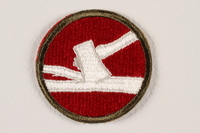
US Army 84th Infantry Division shoulder sleeve patch with an axe splitting a rail
Object
Shoulder sleeve insignia, 84th Infantry Division, United States Army, known as the Railsplitters, of the type used during World War II. The circular red patch depicts a white hatchet splitting a railroad tie. The Unit was activated in 1917 during World War I and drew troops from Illinois, Indiana, and Kentucky; all states important in the life of Abraham Lincoln. They were nicknamed the Lincoln Division in his honor, and later the Railsplitters. The 84th Infantry fought in France, Holland, Belgium, and was in central Germany in May 1945. The Division liberated two subcamps of Neuengamme concentration camp, Hannover-Ahlem on April 10, 1945, and Salzwedel on April 14. Both camps contained many starving and ill prisoners. At Salzwedel, the Division directed the mayor of the nearby town to provide food for the liberated inmates. The 84th Infantry stayed in the region until Germany surrendered on May 7, 1945, becoming part of the Army of Occupation until its return to the United States and inactivation in January 1946.

US Army 71st Infantry Division shoulder sleeve patch with a blue 71 on a red rimmed white circle
Object
Shoulder sleeve insignia, 71st Infantry Division, United States Army, nicknamed the Red Circle, of the type used during World War II. The circular badge features a blue 71 on a white circle with a red border, the national colors. The Unit was activated in 1943 and fought in France and Germany in 1945. While advancing through northern Austria to rendezvous with Soviet forces, the Unit liberated Gunskirchen, a subcamp of Mauthausen concentration camp, on May 5th and 6th. Troops found 15,000 ill and starving prisoners in the camp, which had been abandoned by the SS guards on May 4th. The 71st ordered the nearby town to provide food and water for the liberated inmates. The Division continued on to Linz to meet with the Soviet Army before Germany surrendered on May 7, 1945. The Unit was assigned to the Army of Occupation until its return to the United States and inactivation in March 1946.
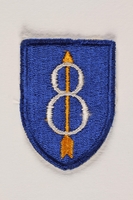
US Army 8th Infantry Division shoulder sleeve patch with an 8 pierced by a yellow arrow
Object
Shoulder sleeve insignia, 8th Infantry Division, United States Army, known as the Golden Arrow or Pathfinder Division, of the type used during World War II. The shield shaped blue badge has an 8 pierced by an upward arrow. The arrow originally represented John Fremont, a famous explorer from California, the state where the Division was activated in 1918. The 8th Infantry fought in France and along the German border to the Elbe River in central Germany. In May 1945, the 8th Infantry and the 82nd Airborne Divisions liberated Wöbbelin, a subcamp of Neuengamme concentration camp, where they found approximately 1000 dead inmates. The Units ordered the people from the nearby town of Ludwigslust to bury the bodies. An additional 200 inmates died from exposure after liberation and the Divisions held public funeral services for them on May 7, 1945, the same day Germany surrendered. The 8th Infantry Division was sent back to the United States in July 1945 and inactivated in November.
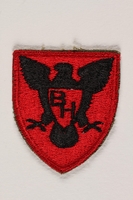
US Army 86th Infantry Division shoulder sleeve patch with a black hawk with spread wings on a red field
Object
Shoulder sleeve insignia of the 86th Infantry Division, United States Army, known as the Blackhawk Division. The monogrammed red shield displays a black hawk with outstretched wings and talons. The Unit, activated in 1917, adopted this insignia in honor of the Native American warrior Blackhawk. Reactivated in 1942, the Unit entered the war in March 1945. It landed in France and quickly advanced into western Germany. The 86th liberated Attendorn, a civilian forced-labor camp in the Olpe District, on April 11, 1945. The Division had crossed the Danube River, and was advancing toward Salzburg, Austria, when Germany surrendered on May 7, 1945. The 86th Infantry processed German prisoners of war for the Army of Occupation until it was redeployed to the Pacific Theater of Operations in June 1945. It was inactivated in the Philippines on December 30, 1946.

US Army 65th Infantry Division shoulder sleeve patch with a white halberd on a blue field
Object
Shoulder sleeve insignia of the 65th Infantry Division, United States Army, nicknamed the Battle Axe, because of their blue badge with a white halberd, a medieval battle axe. The symbol was chosen by the unit's commanding general, Major General Reinhart, to signify the shock action and speed of the infantry. The Division entered the war in January 1945 in France and quickly crossed into Germany. While advancing through Bavaria in early April, they captured the towns of Langensalza and Struth, conquering strong German resistance. On April 20-21, the 65th liberated Hersbruck, a subcamp of Flossenbürg concentration camp. The Unit continued through Bavaria, and had occupied Linz, Austria, by the time Germany surrendered on May 7, 1945. The 65th Infantry was part of the Army of Occupation until it was deactivated in Germany in August 1945.
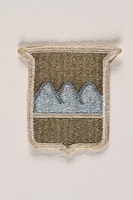
US Army 80th Infantry Division shoulder sleeve patch with three blue mountains
Object
Shoulder sleeve insignia of the 80th Infantry Division, United States Army, called the Blue Ridge Division, with a light green badge with three blue mountains. When the Unit was activated in 1917, it was composed of soldiers from the states of Pennsylvania, West Virginia, and Virginia, through which the Blue Ridge Mountains pass. The 80th Infantry landed in Normandy, France, in August 1944 and began fighting German forces in Argentan. The Division participated in the Battle of the Bulge in December, and then pushed into central Germany. They provided relief to the 6th Armored Division at Buchenwald concentration camp on April 12, 1945, and continued into Austria and liberated the prisoners in Ebensee slave labor camp, a subcamp of Mauthausen concentration camp, on May 4th and 5th. The conditions were so terrible that several hundred inmates died the day the camp was liberated. Germany surrendered on May 7, 1945 and the 80th Infantry Division became part of the Army of Occupation in Austria until their return to the US and inactivation in January 1946.

US Army 99th Infantry Division shoulder sleeve patch with a blue and white checkerboard
Object
Shoulder sleeve insignia of the 99th Infantry Division, United States Army, known as the Checkerboard Division or Battle Babies. The black badge has a blue and white checkerboard band. The design is based on the chequy or checkerboard coat of arms of William Pitt, namesake of the city of Pittsburgh, Pa, the Unit’s headquarters when it was formed in 1942. The 99th was given the Battle Babies nickname by the press during the Battle of the Bulge in December 1944. The Division advanced into Bavaria, where troops liberated four concentration camps in the Mühldorf subcamp complex of Dachau on May 3rd and 4th, freeing 1500 prisoners, nearly half in need of immediate hospitalization. Germany surrendered on May 7, 1945, and the Division became part of the Army of Occupation until their return to the United States and inactivation in October 1945.
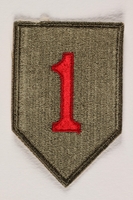
US Army 1st Infantry Division shoulder sleeve patch with a big red numeral one on a green field
Object
Shoulder sleeve insignia of the 1st Infantry Division, United States Army, the oldest continuously serving division in the Army. The Division is nicknamed the Big Red One in honor of their light green badge with a red Arabic numeral one on a light green field and for their status as the first US Division to land in France during World War I. The 1st stormed Omaha Beach in Normandy on D-Day, June 6, 1944. They moved north to capture Aachen, Germany, in October 1944 and held the line at Bullingen, Belgium, during the Battle of the Bulge in December 1944. By the time Germany surrendered on May 7, 1945, the 1st Infantry had pushed through Germany to Czechoslovakia. On May 8th, the 1st Infantry Division and the 9th Armored Division liberated Zwodau and Falkenau an der Eger, subcamps of Flossenbürg concentration camp. They provided medical aid and food to the starving female prisoners of both labor camps. The 1st Infantry Division stayed in Europe as part of the Army of Occupation until 1955.

US Army 2nd Infantry Division shoulder sleeve patch with a Native American caricature on white star
Object
Shoulder sleeve insignia of the 2nd Infantry Division, United States Army, nicknamed the "Indianhead Division" due to the design of their black badge with a cartoonlike head of a Native American on a white star. The patch was created by the unit’s troops during World War 1. The unit landed on Omaha Beach on D Day plus one, June 7, 1944, and were in Germany in October. In early April 1945, the division occupied Hadamar, liberating a psychiatric clinic that was a major killing center for the Nazi euthanasia program for the physically and mentally disabled. The unit provided aid for the remaining inmates. They then liberated Leipzig-Schönfield concentration camp, a subcamp of Buchenwald, on April 14, 1945, where they interred the uncovered corpses in graves. On the following day, troops liberated Spergau/Zöschen labor education camp in Zöschen. The division continued into Czechoslovakia in early May, taking the city of Pilsen on VE Day, May 8th. The unit remained in Pilsen until they returned to the US on July 10, 1945 to train for a scheduled invasion of Japan. The division was still in training when victory over Japan was announced on August 14, 1945.
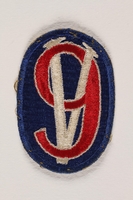
US Army 95th Infantry Division shoulder sleeve patch with a 9 on a Roman numeral V
Object
Shoulder sleeve insignia of the United States Army 95th Infantry Division, nicknamed the Victory Division, derived from the red, white, and blue badge with the Arabic numeral 9 and Roman numeral V for 5. The 95th landed in France on September 15, 1944, and by October had reached the Roselle River. On November 14th, the division joined the offensive drive on the city of Metz, which was secured on November 22nd, earning them the nickname Iron Men of Metz and the Bravest of the Brave. In April, the 95th liberated the German labor education camp in Perl and on April 7, 1945, discovered a prisoner of war camp with over 5000 French soldiers to whom they provided much needed food rations. The unit ended combat operations in Leipzig on VE Day, May 8th, and remained on occupational duty until returning to the US on July 29th to train for war in the Pacific. The division was demobilized soon after the war ended in Japan on August 15 and was inactivated on October 15, 1945.
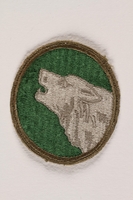
US Army 104th Infantry Division shoulder sleeve patch with a howling gray timberwolf
Object
Shoulder sleeve insignia of the United States Army 104th Infantry Division, nicknamed the Timberwolf Division. The circular, green badge has a gray timberwolf, native to the Pacific Northwest, where the Division originated in 1921. The 104th landed in France on September 7, 1944, and reached Aachen, Germany, a month later. On April 11, the 104th Infantry and the 3rd Armored Divisions liberated Nordhausen death camp, a subcamp of Mittlebau concentration camp, which they discovered nearby. Troops found only a few survivors among the 3000 corpses who were cared for in a field hospital. Local German civilians were ordered to gather and bury the dead in the city’s main cemetery. The unit then captured Halle on April 19 after a five day struggle. Relieved by Soviet forces, the unit reached Pretzsch on April 26th, where, after the May 7 surrender by Germany, they remained on occupation duty until returning to the US on June 27th. The division was inactivated on December 20, 1945.

US Army 29th Infantry Division shoulder sleeve patch with a blue and gray monad
Object
Shoulder sleeve insignia of the United States Army 29th Infantry Division, nicknamed the Blue and Gray Division, based on their circular blue and gray badge with a yin-yang design, or monad, a Korean symbol of eternal life. The colors symbolize the Division tradition of being formed by men whose forefathers fought in the Civil War, for both Union blue and Confederate gray. The 116th infantry regiment of the 29th Division was part of the first wave assault to land at Omaha Beach on D Day, June 6, 1944. They suffered heavy losses, but pushed on to relieve and reinforce combat units inland. At the end of September they were fighting on the German border and, in March 1945, were ordered to attack in the heavily defended Ruhr industrial region. On April 3rd, the Division liberated Dinslaken civilian labor camp. They had pushed on to the Elbe River when Germany surrendered on May 7, 1945. The 29th Infantry served in the Army of Occupation in Frankfurt and Bremen until returning to the US on January 4, 1946, where they were inactivated on January 17.
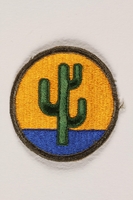
US Army 103rd Infantry Division shoulder sleeve patch with a green cactus on a yellow and blue field
Object
Shoulder sleeve patch of the United States Army 103rd Infantry Division, nicknamed the Cactus Division, based on their circular badge with a Saguaro cactus. The design represents the states, Arizona, Colorado, and New Mexico, whose troops formed the unit when it was established in August 1921. The 103rd arrived in Marseilles, France on October 20, 1944, and crossed into Germany on December 15th. Advancing to the Landsberg area, the 103rd liberated a subcamp within the Kaufering concentration camp system, on April 27, 1945. The division ordered locals to bury the uncovered corpses. The unit had arrived in Innsbruck, Austria, when Germany surrendered on May 7. The 103rd Infantry assumed Amy of Occupation duties until September 10, 1945, when they returned to the US, and were inactivated on September 22, 1945.
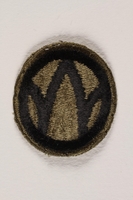
US Army 89th Infantry Division shoulder sleeve patch with a black W monogram on a green field
Object
Shoulder sleeve insignia of the United States Army 89th Infantry Division, known as the Rolling W or the Middle West Division. The circular black and green badge has a W monogram that inverts to become an M, representing the Midwest origin of the troops who formed the Division when it was established in August 1917. During World War II, the 89th landed at Le Havre, France, on January 21, 1945 and crossed the Rhine River on March 26th. The 89th and the 4th Armored Divisions liberated Ohrdruf concentration camp, a subcamp of Buchenwald, on April 4, 1945, the first concentration camp liberated by US troops. The Units forced local residents to view the camp. In late April, the 89th was assigned duties as an army of occupation near Gotha and Armstadt until Germany surrendered on May 7. The Division was relocated to Normandy on May 17 to process the shipment of American troops to the US and Pacific. The 89th Infantry returned to the US on December 16th and was inactivated on December 27, 1945.
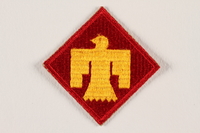
US Army 45th Infantry Division shoulder sleeve patch with a gold Thunderbird on a red field
Object
Shoulder sleeve insignia of the United States Army 45th Infantry Division, nicknamed the Thunderbird Division. The embroidered gold thunderbird design symbolizes the troops from the southwestern states of Oklahoma, New Mexico, Colorado, and Arizona, who formed the unit when it was established in 1942 as a National Guard Division. The 45th landed in North Africa on June 22, 1943, and was redeployed to Sicily for the Italian campaign on July 10. The unit was then sent to southern France in August. The Thunderbird Division crossed the Rhine River in March 1945 and continued into southern Germany, capturing Nuremberg and Munich in late April. With the 42nd Infantry and 20th Armored Divisions, the unit liberated Dachau concentration camp on April 29th and 30th. US Army and Allied representatives treated the sick and brought food for starving survivors at the camp. The civilian residents of the city of Dachau were ordered to bury the dead. The unit was stationed near Dachau after the surrender of Germany on May 7. The 45th returned to the US on September 14, 1945, and was inactivated on December 7, 1945.
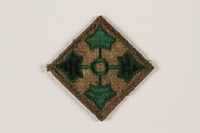
US Army 4th Infantry Division shoulder sleeve patch with 4 green ivy leaves on a brown field
Object
Shoulder sleeve insignia of the United States Army 4th Infantry Division, nicknamed the Ivy Division. The badge displays on point and has four ivy leaves representing the division’s numerical designation, a play on the Roman numeral IV (4). The 4th was the first US unit to land on Utah Beach on D Day, June 6, 1944, and later joined in the liberation of Paris on August 25th. By November 6th, the Division had reached the Hürtigen Forest, where they fought until early December. In late March 1945, the division crossed the Rhine River and campaigned through Germany. In late April, the troops discovered the site of Haunstetten, a subcamp of Dachau concentration camp and one of the largest subcamps in Germany. It had been destroyed on April 13, 1945 by Allied air attacks. The division proceeded to Miesbach and when Germany surrendered on May 7 was assigned occupational duty until their return to the US on July 10th. The unit then prepared for redeployment to Japan, which was halted before VJ Day, August 14, 1945. The division was inactivated on Mach 5, 1945.

US Army 90th Infantry Division shoulder sleeve patch with a red T and O monogram on a black field
Object
Shoulder sleeve insignia of the United States Army 90th Infantry Division, nicknamed the Tough Ombre Division. The division’s insignia with the letters T and O, representing the states of Texas and Oklahoma where the first troops were drafted, is the source of the unit's nickname. The 90th landed on Utah Beach behind the initial assault on D Day, June 6, 1944. The division then advanced into the Saar Region of Germany in early December 1944. On January 5, 1945, the unit was redeployed to Belgium for the Battle of the Bulge. In late April, the 90th advanced to the German/Czech border, where they liberated Flossenbürg concentration camp on April 23, 1945. Troops discovered about 1,500 survivors at the camp and some 6,000 survivors near the camp, who had been forced to evacuate Flossenbürg in death marches. The unit was en route to Prague when Germany surrendered on May 7, 1945. The 90th conducted patrols along the border until their return home on December 16, 1945. The Division was inactivated on December 27, 1945.
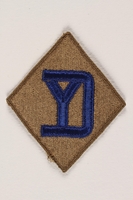
US Army 26th Infantry Division shoulder sleeve patch with a blue YD monogram
Object
Shoulder sleeve insignia of the 26th Infantry Division, United States Army, called the Yankee Division. The blue Y and D monogram on the green patch represents its nickname, which dates from its activation in World War I when it was formed from National Guard units from New England. The 26th Division landed in Normandy on September 7, 1944, and advanced east, capturing several towns. During the Battle of the Bulge, the Division was diverted to Luxembourg. The Division advanced into Germany in March 1945. Its troops liberated Passau concentration camp, a subcamp of Mauthausen, in late April or early May 1945. The SS guards had already abandoned the camp and the prisoners. The Division pushed into Austria, where they participated in the capture of Linz on May 4, 1945. The 26th and the 11th Armored Division liberated Gusen concentration camp, a subcamp of Mauthausen, on May 5. They prevented the Germans from killing all the prisoners by blowing up the camp’s underground tunnels with the inmates inside. The Division had advanced into Czechoslovakia when Germany surrendered on May 7, 1945. The Division was placed on occupation duty until inactivated on December 29, 1945.

US Army 83rd Infantry Division shoulder sleeve patch with a yellow monogram of Ohio
Object
Shoulder sleeve insignia of the 83rd Infantry Division, United States Army, nicknamed the Thunderbolt Division. The Division was formed in Ohio when it was activated in World War I, and the badge insignia has compressed yellow circles and lines that spell OHIO. The 83rd landed in Normandy on June 18, 1944, and advanced through France and Luxembourg into Germany. Troops of the 83rd and 8th Armored Division encountered a group of adjacent subcamps of Buchenwald concentration camp. The 83rd liberated Langenstein subcamp on April 11, 1945, where they found 1,100 severely malnourished prisoners, most weighing only 80 pounds. The Division ordered the local German mayor to provide food and water and requisitioned medical supplies from the US Army’s 20th Field Hospital. They recovered the camp’s documents for use by war crimes investigators. Germany surrendered on May 7, 1945, and the Division was on occupation duty until their return to the US on March 26, 1946. They were inactivated on April 5, 1946.

US Army 69th Infantry Division shoulder sleeve patch with a stylized red and blue 69
Object
Shoulder sleeve insignia of the 69th Infantry Division, United States Army, nicknamed the Fighting Sixty-Ninth. The patch design has stylized 69 numerals, in the national colors of red, white, and blue. The 69th Division landed in Le Havre, France, on January 24, 1945, and advanced through France and Belgium into Germany. On April 19, 1945, the Division captured Leipzig. Unit troops discovered Leipzig-Thekla concentration camp, a subcamp of Buchenwald. The SS guards had set fire to the barracks with 300 people inside the day before and the 69th immediately began providing aid for the 90 to 100 survivors. Germany surrendered on May 7, 1945, and the Division remained on occupation duty until their return to the US on September 13, 1945. They were inactivated on September 16, 1945.
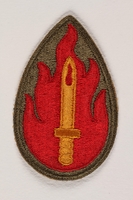
US Army 63rd Infantry Division shoulder sleeve patch with a golden sword within a red flame
Object
Shoulder sleeve insignia of the 63rd Infantry Division, United States Army, nicknamed the Blood and Fire Division. The Division’s nickname and insignia are inspired by a quote by Winston Churchill: “the enemy would bleed and burn in expiation of their crimes against humanity.” The 63rd Division arrived in Marseilles, France, on December 8, 1944. They pushed into Germany, where a battalion was ordered to search the Landsberg area for subcamps of Dachau concentration camp. They discovered seven of the eleven Kaufering subcamps on April 29 and 30, 1945, and found hundreds of weak and sick prisoners. Germany surrendered on May 7, 1945, and the Division was placed on occupation duty until inactivated on September 27, 1945.

US Army 42nd Infantry Division shoulder sleeve patch with a red, yellow and blue rainbow
Object
Shoulder sleeve insignia of the 42nd Infantry Division, United States Army, known as the Rainbow Division. The Unit was activated in 1917 and drew troops from 26 states, making it the most diverse Division and winning it the nickname Rainbow. The 42nd Division captured the German cities of Wurzburg, Schweinfurt, and Furth in April 1945, and then crossed into Bavaria, where it was one of three Army divisions to liberate Dachau concentration camp on April 29, 1945. The 42nd Infantry, 45th Infantry, and 20th Armored Divisions liberated more than 30,000 prisoners, but found many that were dying or had recently died from the terrible conditions, including more than 2000 corpses on a transport train outside the main gate. While US and Allied representatives treated the prisoners, the 42nd Infantry continued its march into Austria until Germany surrendered on May 7, 1945. The Unit then became part of the Army of Occupation until inactivation in Europe on June 19, 1946.

